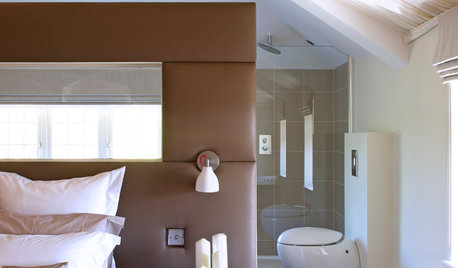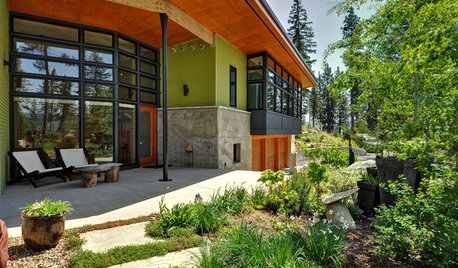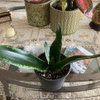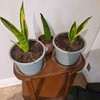I have noticed a couple of things about my Sansevieria collection over the past few years, and wanted to share with everyone:
Most of my plants grow leaves in the fall/winter/spring, and have most of their underground new growth in spring/summer/fall. I noticed this for most of my plants while repotting. I try to repot in the spring, so that I can have a long season of growth with optimal conditions (I live in Zone 6) before it gets cool and dry. I noticed that any plants that had been slipped from their pots in the fall to check on progress hadn't produced a lot of rhizome growth over the winter, but my plants pretty much fill the pots with roots over the course of a single summer. I've also noticed that it sometimes takes a few years before rhizome production (and new plants) really take off. I haven't figured out why some plants will not produce new rhizomes every year, but I suspect it has to do with both the size of the plant and the maturity of the growth.
My S. cylindrica is a pretty big plant (over 4' tall), and it doesn't seem to want to push a new growth every year. It seems that it will only do this when the previous growth has matured beyond three large leaves, which can take 2 or three years for me. This plant has flowered for me, and each growth gets substantially larger than the previous before it flowers. My first plant had three leaves 24" tall when it flowered. The current growth has four leaves twice the diameter of the original plant 48" tall, and is showing no signs of flowering yet.
I've experienced similar situation with S. hallii, which doesn't produce a new growth until it has grown 3/4 the size of the parent plant. My S. hallii also took a couple of years to grow beyond a single leaf per growth, and the single leaves were only about 12" - now that I am getting two-leafs per growth, the leaves are 24-30" each. I haven;t had it flower yet, but the root system is getting substantially larger and heavier, so I expect something to happen when the pot is filled in another few years.
My S. masoniana has had a similar growth pattern, but it is pretty dependable in sending out yearly shoots. The first year I had it, it was just a single leaf with a short rhizome that the growth tip had been removed from. It took two years to produceit's first shoot (which was another single leaf), and then it produced at least one (sometimes three) growths per year. I attribute this to the rhizome branching. It took almost 5 years before it produced two leaves per growth, now it does that dependably. The largest leaves are about 24" tall and 8" wide. These leavs will usually break through the ground in August, and continue to grow for almsot a year. I haven't had any flowers yet, but I know it is only a matter of time. My repotting this specimin (and taking cuttings every few years) can be slowing the flowering down.
I've noticed that my variegated plants grow much slower than my non-variegated plants (trifasciata excluded). My S. hallii, cylindrica, fisherii and parva all grow MUCH slower than the non-variegated types. Also, I've noticed that WHITE variegates grow slower than YELLOW variegates, and are more sensitive to both sun and overwatering.
My S. parva (green) produces lots of stolens every winter - this year I have an 8" pot filled with parva that is sending out 25 stolens (that I can see). All of these will be large enough to seperate in the spring, but will probably take a year or two before they become heavy producers themselves. S. parva seems to want to get pretty big (for a small Sansevieria) before it will flower - mine all grow sn above-ground stem with leaves of about 1.5" before they flower. They also seem to produce a lot more stolens when they flower. This year, the pot has 2 plants flowering, which I attribute all the stolens to. Next year should be even better, as I expect 4 or 5 plants in that pot to be mature enough to flower. This plant was started from a single small plant 4 years ago, and now completely fills an 8" azelea pot.
I've leaqrned not to pot my sansevieria in gorwers pots (cylindical black pots with drainage on the bottom and sides). They are difficult to remove from the cylindrical pots (tapered are easier to use), and the shoots will always try and grow out of the side drainage holes. Many of my plants have heavy, thich rhizomes which will deform the sides of a pot - for these I prefer to use clay. It can be very difficult to remove a large plant from a deformed pot without cutting the pot, and large plants never give me a convenient place to cut the pot without doing damage to the plant.
These ramblings were in no particular order. I hope that this information is useful to the group, and I'll post more of my observations in the next few weeks.
Joe 'always helpful' DeRosa



















oosterholt
marguerite_gw Zone 9a
Related Professionals
Kenmore Landscape Architects & Landscape Designers · Piqua Landscape Architects & Landscape Designers · Berkley Landscape Contractors · Bridgeview Landscape Contractors · El Mirage Landscape Contractors · Florham Park Landscape Contractors · Northbridge Landscape Contractors · Pleasant Hill Landscape Contractors · Riverview Landscape Contractors · Saint John Landscape Contractors · Chicago Ridge Landscape Contractors · 45056 Window Contractors · Clarksburg Window Contractors · Holly Hill Window Contractors · Lake Arrowhead Window Contractorsjon_d
biwako_of_abi
jover
jon_d
biwako_of_abi
jover
elsier
biwako_of_abi